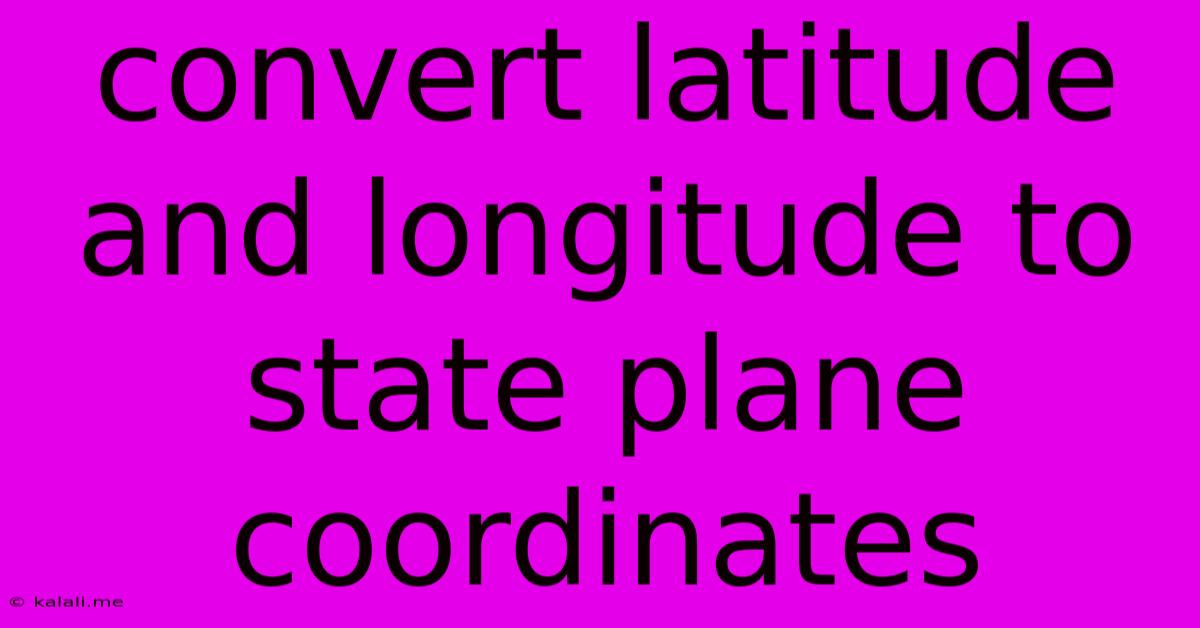Convert Latitude And Longitude To State Plane Coordinates
Kalali
Jun 04, 2025 · 4 min read

Table of Contents
Converting Latitude and Longitude to State Plane Coordinates: A Comprehensive Guide
Meta Description: Learn how to accurately convert latitude and longitude coordinates to State Plane Coordinates using various methods and tools. This guide covers the process, explains different coordinate systems, and offers practical tips for successful conversion.
Geographic coordinates, expressed as latitude and longitude, are a global referencing system ideal for broad location identification. However, for many surveying, mapping, and engineering applications, these coordinates lack the precision and accuracy needed for local projects. This is where State Plane Coordinates (SPC) come in. SPC are a system of projected coordinates designed for specific regions within a state, offering significantly improved accuracy over large-scale geographic coordinates. This article will guide you through the process of converting latitude and longitude to State Plane Coordinates.
Understanding Coordinate Systems
Before diving into the conversion process, it's crucial to understand the fundamental differences between latitude/longitude and State Plane Coordinates.
-
Latitude and Longitude: These are geographic coordinates based on a spherical Earth model. Latitude measures the angle north or south of the equator, while longitude measures the angle east or west of the Prime Meridian. They are expressed in degrees, minutes, and seconds (DMS) or decimal degrees.
-
State Plane Coordinates: These are projected coordinates, meaning they are transformed from the curved surface of the Earth onto a flat plane using a specific map projection. This projection minimizes distortion within a defined zone, making SPC ideal for accurate local measurements. The United States uses different zones for each state (or parts thereof), each employing a unique map projection (typically Transverse Mercator or Lambert Conformal Conic). This is why specifying the zone is vital during the conversion.
Methods for Conversion
Several methods exist for converting latitude and longitude to State Plane Coordinates. These include:
-
Online Converters: Numerous websites offer free online tools for this conversion. Simply input your latitude and longitude, select the appropriate State Plane Coordinate Zone (this is critical!), and the tool will calculate the corresponding Easting and Northing coordinates. Remember to carefully verify the zone selection – an incorrect zone will result in significantly inaccurate coordinates.
-
GIS Software: Geographic Information System (GIS) software packages like ArcGIS and QGIS offer robust tools for coordinate transformations. These programs provide more advanced features and often handle projections and datums with greater accuracy. They usually incorporate numerous coordinate systems, ensuring precise conversions.
-
Programming Libraries: For those comfortable with programming, libraries in languages such as Python (with packages like
pyproj) allow for programmatic conversions. This approach offers flexibility and automation for large-scale conversions. This method requires a strong understanding of coordinate systems and projection parameters.
Essential Information for Conversion
To successfully convert latitude and longitude to State Plane Coordinates, you'll need the following information:
- Latitude and Longitude: The geographic coordinates you wish to convert.
- State Plane Coordinate Zone: This is the specific zone within the State Plane Coordinate system that encompasses your location. This information is crucial for an accurate conversion, as different zones use different projections. The zone number is usually a combination of state and zone.
- Datum: The datum defines the reference surface for the coordinates. Common datums include NAD83 and NAD27 in the United States. Specifying the correct datum ensures consistent results.
Practical Tips and Considerations
- Accuracy: The accuracy of your conversion depends on the accuracy of your input data and the method employed. Online converters generally offer sufficient accuracy for many purposes, while GIS software provides higher precision.
- Zone Selection: Double-check and verify the State Plane Coordinate zone before performing the conversion. Using the wrong zone will lead to significant errors.
- Datum Consistency: Ensure consistency in the datum used throughout the process. Mixing datums will result in inaccurate results.
- Understanding Projections: A basic understanding of map projections can help in interpreting the results and understanding the limitations of the conversion.
By following these guidelines and utilizing the appropriate tools, you can accurately convert latitude and longitude coordinates to State Plane Coordinates, ensuring precision for your local mapping and surveying needs. Remember to always double-check your work and ensure you’re using the correct parameters. The accuracy of your converted coordinates directly impacts the reliability of any subsequent analysis or application.
Latest Posts
Latest Posts
-
Can I Use A Godox Transmitter With A Neewer Flash
Jun 05, 2025
-
Should I Get A Radon Test With Home Inspection
Jun 05, 2025
-
Why Cant I Type Special Characters In Minecraft
Jun 05, 2025
-
Where Is My Water Pressure Regulator
Jun 05, 2025
-
Can The Sun Be Used To Amplify Radio Waves
Jun 05, 2025
Related Post
Thank you for visiting our website which covers about Convert Latitude And Longitude To State Plane Coordinates . We hope the information provided has been useful to you. Feel free to contact us if you have any questions or need further assistance. See you next time and don't miss to bookmark.